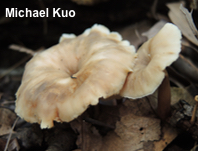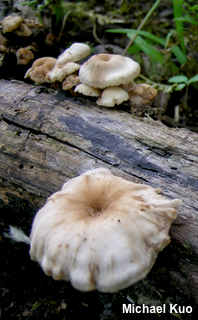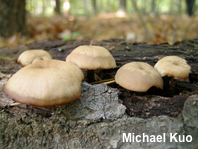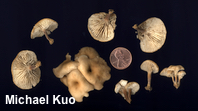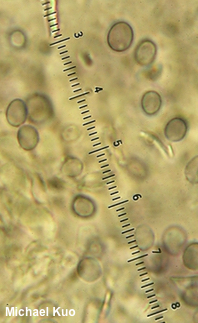| Major Groups > Gilled Mushrooms > Saw-Gilled Mushrooms > Lentinellus micheneri |

|
[ Basidiomycota > Russulales > Auriscalpiaceae > Lentinellus . . . ] Lentinellus micheneri by Michael Kuo, 11 September 2025 Like other species of Lentinellus, Lentinellus micheneri has distinctively saw-toothed, jagged gill edges and amyloid spores that are finely ornamented. The spore print is white, and the taste is often acrid or peppery. Features separating micheneri from other lentinelluses (that's a word all day long) include its "omphalinoid" stature (it has a smallish cap that develops a deep navel), its growth on the deadwood of hardwoods (or, in Europe, also on the wood of conifers), its brown to pale brown colors, and its frequently grooved stem. I am including at least three cryptic biological species in what I'm calling "Lentinellus micheneri." Mating studies by Ron Petersen (Petersen & Hughes 2004) found that micheneri-like specimens from Europe and North America were a little picky about which other specimens they were willing to hook up with in petri dishes, leading the authors to separate Lentinellus micheneri, Lentinellus subaustralis, and Lentinellus flabelliformis (the latter species was the earliest named of the three, so perhaps I should be using that name for the species group, as the Europeans do). Unfortunately the species in this group are virtually inseparable without mating studies or ITS sequences; putative separators like the shades of brown manifested in dried caps, minuscule differences in spore size, and "acrid" taste versus "consistently anesthetic to the tip of the tongue" are not actually reliable, in my experience, and may well overlap enough to make assessing them an exercise in futility—unless you have collected a "flabelliform" specimen of Lentinellus flabelliformis, in which case identification is pretty straightforward. However, flabelliformis is just as likely to manifest omphalinoid fruiting bodies, despite its Latin name, and then we are back into inseparability. Lentinellus omphalodes is another name sometimes used in this species group. Description: Ecology: Saprobic; growing alone, scattered, or (most commonly) gregariously, in small clusters on deadwood of hardwoods (North America) or conifers (Europe), or appearing terrestrial amid woody debris; spring through fall; originally described from Pennsylvania (Berkeley & Curtis 1853); distributed as a species group (see above) throughout Europe and North America. The illustrated and described collections are from Illinois. Cap: 1–5 cm; convex or cushion-shaped when young, with a central depression; later broadly convex or nearly flat, with a deep central depression; moist; bold; brown to pinkish brown or paler; hygrophanous; the margin not lined. Gills: Broadly attached to the stem or beginning to run down it; close or nearly distant; short-gills frequent; the edges distinctively saw-toothed; white, becoming grayish to brownish; not bruising. Stem: 15–40 mm long; 2–4 mm thick; more or less equal, or with a flared apex; frequently grooved longitudinally; brown or reddish brown; sometimes off-center; basal mycelium white, becoming rusty brown. Flesh: Whitish to pale brownish; unchanging when sliced; tough. Odor and Taste: Odor not distinctive; taste acrid or peppery (sometimes developing slowly). Chemical Reactions: KOH negative on fresh cap surface. Spore Print: White. Microscopic Features: Spores 4–6 x 3–4.5 µm; ellipsoid or broadly ellipsoid; sparsely, finely ornamented (appearing virtually smooth with light microscopy); amyloid. Basidia 22–25 x 4–5 µm; subclavate; 4-sterigmate. Pleurocystidia inconspicuous; up to 30 x 8 µm; lageniform. Pileipellis a cutis of elements 4–8 µm wide. Clamp connections present. REFERENCES: (M. J. Berkeley & M. A. Curtis, 1853) D. N. Pegler, 1983. (Miller & Stewart, 1971; Arora, 1986; Phillips, 1991/2005; Lincoff, 1992; Petersen & Hughes, 2004; Miller & Miller, 2006; Kuo & Methven, 2014; Sturgeon, 2018; McKnight et al., 2021.) Herb. Kuo 10090308, 05270406, 05290706, 09011605. This site contains no information about the edibility or toxicity of mushrooms. |
© MushroomExpert.Com |
|
Cite this page as: Kuo, M. (2025, September). Lentinellus micheneri. Retrieved from the MushroomExpert.Com Web site: http://www.mushroomexpert.com/lentinellus_micheneri.html |
